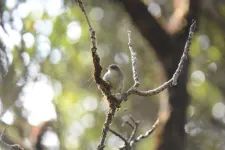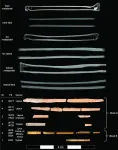(Press-News.org) Looking to inform the conservation of critically endangered bird species, University of Utah biologists completed an analysis identifying traits that correlate with all 216 bird extinctions since 1500.
Species most likely to go extinct sooner were endemic to islands, lacked the ability to fly, had larger bodies and sharply angled wings, and occupied ecologically specific niches, according to research published this month.
While some of these findings mirror previous research on extinct birds, they are the first to correlate bird traits with the timing of extinctions, said lead author Kyle Kittelberger, a graduate student in the School of Biological Sciences.
“I’ve been very interested in extinctions and understanding the species that we’ve lost and trying to get a sense of how we can use the past to better inform the present and future,” said Kittelberger, who is completing his dissertation on how the bodies and wings of certain species of migratory songbirds have changed in response to climate change.
His team’s analysis tapped into BirdBase, a dataset of ecological traits for the world’s 11,600+ bird species compiled by U biology professor Çağan Şekercioğlu and the Biodiversity and Conservation Ecology Lab at the U. The team simultaneously analyzed a broad range of biogeographical, ecological and life history traits previously associated with extinction and extinction risk for bird species that have gone extinct as well as those that lack recent confirmed sightings and have therefore disappeared.
“Importantly, we examine biological correlates of bird extinctions through the lens of when birds went extinct, providing a novel extinction timing element that helps better inform why birds with certain traits disappeared when they did,” Kittelberger wrote in a series of posts on X. By identifying traits that most predispose birds to extinction, the findings can help guide conservation efforts of hundreds of species that are at peril.
“One of the strengths of the approach that we use is we compared all of these traits simultaneously against each other, whereas a lot of previous studies in the literature just look at traits in isolation.”
While only around 2% of the world’s bird species have gone extinct since 1500, the year Kittelberger’s analysis begins, even more had already disappeared by then. Before 1500, however, there is not as reliable a record of the birds that went extinct and data on their traits and characteristics.
This timing coincides with the rise of scientific observation, resulting in a systematic documentation of plant and animal life. It is also the time when European exploration took off, leading to the disruption of ecosystems around the globe as a result of colonization and introduced species.
Today, 1,314 bird species are at risk of extinction, according to the IUCN Red List of Threatened Species, or about 12% of the total.
Many species, such as the ‘Akikiki (Oreomystis bairdi), endemic to the Hawaiian island of Kauai, are so rare that they are functionally extinct. Kittelberger photographed the pictured ‘Akikiki, also called Kauai’s creeper, in the Alaka‘i Wilderness Preserve in 2022, when it was believed around 70 or so remained in the wild; today, only one individual remains.
The proportion of 216 bird species globally extinct or likely lost since 1500 that were endemic to a region, found solely on islands, and were either flightless or partially flightless, as well as the breakdown of species by primary habitat or diet.
As with many other Hawaiian bird species, the main threat to the ’Akikiki comes in the form of introduced species, principally malaria-carrying mosquitoes and habitat-wrecking livestock, according to Hawaii’s Division of Forestry and Wildlife.
The single most critical trait associated with extinction is insularity, those species endemic to islands. Other traits that appear to increase extinction risk, such as body size, wing shape and ecological specialization, are also associated with island insularity.
Pacific islands are home to a vast array of endemic species, many of which are now on the IUCN list. No archipelago has seen more loss of avian biodiversity than Hawaii, which accounts for 34 post-1500 extinctions, according to the study.
The bird family that experienced the most extinctions is Rallidae, or rails, which are globally distributed medium-sized semi-amphibious bird species. This family lost 26 members, while the entire line of the Mohoidae family, small nectar-sipping songbirds commonly known as Hawaiian honeyeaters, is completely gone (the only bird family to go fully extinct in modern times). The family’s last member, the Kauai O’o (Moho braccatus), was last observed in 1987.
The finding that did surprise Kittelberger’s team was the correlation of wing shape to extinction. They found that bird species with a larger hand-wing index, that is more pointed wings, were more likely to have vanished earlier. Since pointier wings indicate stronger flying and dispersal abilities, the team predicted such birds would be better equipped to respond to environmental pressures than those with rounder wings.
Yet birds with rounder wings, those with smaller hand-wing ratios, proved to be more resilient.
“It likely ties with the fact that a lot of these birds that went extinct were on islands. For these species or their ancestors to have arrived at these islands to begin with, they would’ve needed the ability to fly across large, open distances. So a lot of these birds on islands have, not necessarily longer, but more pointed wings,” Kittelberger said. “Think of a swift or a swallow or a bird like an albatross that flies over the ocean. They have really pointy wings that allow them to fly really well, whereas birds in dense tropical rainforests are not flying these large distances, so they have rounded wings because they’re just moving in their local habitat patches.”
Ecological specialists, as opposed to generalists, face great challenges when their specific ecological niche is altered, so they tend to be less able to respond and adapt to disturbances, like invasive species or disruption of a food source.
In other findings, the study concluded more than 87% were endemic to islands; nearly two-thirds inhabited forests; 45% ate primarily insects and other invertebrates; and 20% were completely or partially flightless. Finally, species with big bodies were overly represented on the extinct list.
“Heavier birds have been more likely to be targeted for hunting, with several well-known examples of birds being hunted to extinction in part for food, including the Dodo, Great Auk (Pinguinus impennis), and Spectacled Cormorant (Urile perspicillatus),” the study said. “Body mass has also been linked with a species’ inhabitance of islands, as island birds tend to be larger than mainland species.” Of the 43 species whose average body weight exceeded 500 grams, or 1.1 pounds, three-quarters were endemic to an island.
The decade of the 1890s saw the highest number on extinctions, with 21 recorded. The 1980s was another bad decade for bird loss with 20 species, including the Kauai O’o. This latter decade “is noteworthy since focused and targeted conservation efforts were already underway globally before and during this period,” the study said. “Though the rate of extinction declined in the subsequent decades, the number of globally threatened species has only increased.”
The study, “Correlates of avian extinction timing around the world since 1500 CE,” was published Nov. 7 in the journal Avian Research. The research team included Colby J. Tanner, Amy N. Buxton, Amira Prewett and Çağan Şekercioğlu. Support for this research came from the University of Utah’s Graduate Research Fellowship.
END
Discovering the traits of extinct birds
Analysis by Utah biologists found birds endemic to islands, lacking flight, with large bodies and sharply angled wings were more likely to disappear first
2024-11-27
ELSE PRESS RELEASES FROM THIS DATE:
Are health care disparities tied to worse outcomes for kids with MS?
2024-11-27
MINNEAPOLIS – People who develop multiple sclerosis (MS) as children and grow up in less advantaged neighborhoods may have a larger volume of inflammation and brain tissue loss on imaging than those who grow up in more advantaged neighborhoods, according to a study published in the November 27, 2024, online issue of Neurology®, the medical journal of the American Academy of Neurology.
MS rarely develops in children. About 5% of people with MS are diagnosed before age 18.
In addition to neighborhood location, worse brain imaging outcomes were also seen ...
For those with CTE, family history of mental illness tied to aggression in middle age
2024-11-27
EMBARGOED FOR RELEASE UNTIL 4 P.M. ET, WEDNESDAY, NOVEMBER 27, 2024
MINNEAPOLIS – People who have chronic traumatic encephalopathy (CTE) who have a family history of mental illness may have a higher risk of aggression in middle age, according to a study published in the November 27, 2024, online issue of Neurology®, the medical journal of the American Academy of Neurology.
CTE is a neurodegenerative disease associated with repeated head injuries, often seen in athletes and military personnel, that can lead to mood changes and dementia.
“This ...
The sound of traffic increases stress and anxiety
2024-11-27
Manmade sounds such vehicle traffic can mask the positive impact of nature soundscapes on people’s stress and anxiety, according to a new study published November 27, 2024, in the open-access journal PLOS ONE by Paul Lintott of the University of the West of England, U.K., and Lia Gilmour of the Bat Conservation Trust, U.K.
Existing research shows that natural sounds, like birdsong, can lower blood pressure, heart, and respiratory rates, as well as self-reported stress and anxiety. Conversely, anthropogenic soundscapes, like traffic or aircraft noise, are hypothesized to have negative effects on human health and wellbeing in a variety ...
Global food yields have grown steadily during last six decades
2024-11-27
Contrary to widespread concerns that global crop yields have stagnated in recent decades, a comprehensive study of worldwide food production finds yields have continued to grow at roughly the same rate since the 1960s. John Baffes of the World Bank and Xiaoli Etienne of the University of Idaho, U.S., report these findings on November 27, 2024, in the open-access journal PLOS ONE.
Almost 10 billion people are expected to inhabit Earth by 2050, so agricultural production will become increasingly critical ...
Children who grow up with pets or on farms may develop allergies at lower rates because their gut microbiome develops with more anaerobic commensals, per fecal analysis in small cohort study
2024-11-27
Children who grow up with pets or on farms may develop allergies at lower rates because their gut microbiome develops with more anaerobic commensals, per fecal analysis in small cohort study
###
Article URL: https://journals.plos.org/plosone/article?id=10.1371/journal.pone.0313078
Article Title: Gut microbiota markers in early childhood are linked to farm living, pets in household and allergy
Author Countries: Sweden
Funding: This work was supported by the Region Västra Götaland (agreement concerning medical research and education – ALF), https://www.alfvastragotaland.se [ALFGBG966243] [ALFGBG720181] ...
North American Early Paleoindians almost 13,000 years ago used the bones of canids, felids, and hares to create needles in modern-day Wyoming, potentially to make the tailored fur garments which enabl
2024-11-27
North American Early Paleoindians almost 13,000 years ago used the bones of canids, felids, and hares to create needles in modern-day Wyoming, potentially to make the tailored fur garments which enabled their dispersal into these colder climates
###
Article URL: https://journals.plos.org/plosone/article?id=10.1371/journal.pone.0313610
Article Title: Early Paleoindian use of canids, felids, and hares for bone needle production at the La Prele site, Wyoming, USA
Contact: Spencer Pelton, spencer.pelton@wyo.gov, Ph. +1 307 399 2827
Author Countries: U.S.
Funding: Funding for this project includes the National Science Foundation (award #1947297), the ...
Higher levels of democracy and lower levels of corruption are associated with more doctors, independent of healthcare spending, per cross-sectional study of 134 countries
2024-11-27
Higher levels of democracy and lower levels of corruption are associated with more doctors, independent of healthcare spending, per cross-sectional study of 134 countries.
###
Article URL: https://journals.plos.org/globalpublichealth/article?id=10.1371/journal. pgph.0003656
Article Title: The relationship between democracy and corruption and the global physician workforce
Author Countries: Canada
Funding: The authors received no specific funding for this work. END ...
In major materials breakthrough, UVA team solves a nearly 200-year-old challenge in polymers
2024-11-27
Researchers at the University of Virginia School of Engineering and Applied Science have developed a new polymer design that appears to rewrite the textbook on polymer engineering. No longer is it dogma that the stiffer a polymeric material is, the less stretchable it has to be.
“We are addressing a fundamental challenge that has been thought to be impossible to solve since the invention of vulcanized rubber in 1839,” said Liheng Cai, an assistant professor of materials science and engineering, and chemical engineering.
That’s when Charles Goodyear accidentally discovered that heating natural rubber with sulfur ...
Wyoming research shows early North Americans made needles from fur-bearers
2024-11-27
A Wyoming archaeological site where people killed or scavenged a Columbian mammoth nearly 13,000 years ago has produced yet another discovery that sheds light on the life of these early inhabitants of North America.
Wyoming State Archaeologist Spencer Pelton and colleagues at the University of Wyoming and other institutions have found that these Paleolithic humans made needles from the bones of fur-bearers -- including foxes; hares or rabbits; and cats such as bobcats, mountain lions, lynx and possibly even the now-extinct ...
Preclinical tests show mRNA-based treatments effective for blinding condition
2024-11-27
A new preclinical study by Mass Eye and Ear investigators showed that a novel mRNA-based therapy may be able to prevent blindness and scarring from proliferative vitreoretinopathy (PVR) following a retinal detachment repair or traumatic injury to the eye. There is no current treatment for PVR other than surgery, which itself carries a high risk of causing or exacerbating PVR. Their results, published in Science Translational Medicine, show the promise that mRNA-based therapies may one day offer patients with PVR and other retinal conditions.
“This ...
LAST 30 PRESS RELEASES:
Numbers in our sights affect how we perceive space
SIMJ announces global collaborative book project in commemoration of its 75th anniversary
Air pollution exposure and birth weight
Obstructive sleep apnea risk and mental health conditions among older adults
How talking slows eye movements behind the wheel
The Ceramic Society of Japan’s Oxoate Ceramics Research Association launches new international book project
Heart-brain connection: international study reveals the role of the vagus nerve in keeping the heart young
Researchers identify Rb1 as a predictive biomarker for a new therapeutic strategy in some breast cancers
Survey reveals ethical gaps slowing AI adoption in pediatric surgery
Stimulant ADHD medications work differently than thought
AI overestimates how smart people are, according to HSE economists
HSE researchers create genome-wide map of quadruplexes
Scientists boost cell "powerhouses" to burn more calories
Automatic label checking: The missing step in making reliable medical AI
Low daily alcohol intake linked to 50% heightened mouth cancer risk in India
American Meteorological Society announces Rick Spinrad as 2026 President-Elect
Biomass-based carbon capture spotlighted in newly released global climate webinar recording
Illuminating invisible nano pollutants: advanced bioimaging tracks the full journey of emerging nanoscale contaminants in living systems
How does age affect recovery from spinal cord injury?
Novel AI tool offers prognosis for patients with head and neck cancer
Fathers’ microplastic exposure tied to their children’s metabolic problems
Research validates laboratory model for studying high-grade serous ovarian cancer
SIR 2026 delivers transformative breakthroughs in minimally invasive medicine to improve patient care
Stem Cell Reports most downloaded papers of 2025 highlight the breadth and impact of stem cell research
Oxford-led study estimates NHS spends around 3% of its primary and secondary care budget on the health impacts of heat and cold in England
A researcher’s long quest leads to a smart composite breakthrough
Urban wild bees act as “microbial sensors” of city health.
New study finds where you live affects recovery after a hip fracture
Forecasting the impact of fully automated vehicle adoption on US road traffic injuries
Alcohol-related hospitalizations from 2016 to 2022
[Press-News.org] Discovering the traits of extinct birdsAnalysis by Utah biologists found birds endemic to islands, lacking flight, with large bodies and sharply angled wings were more likely to disappear first









